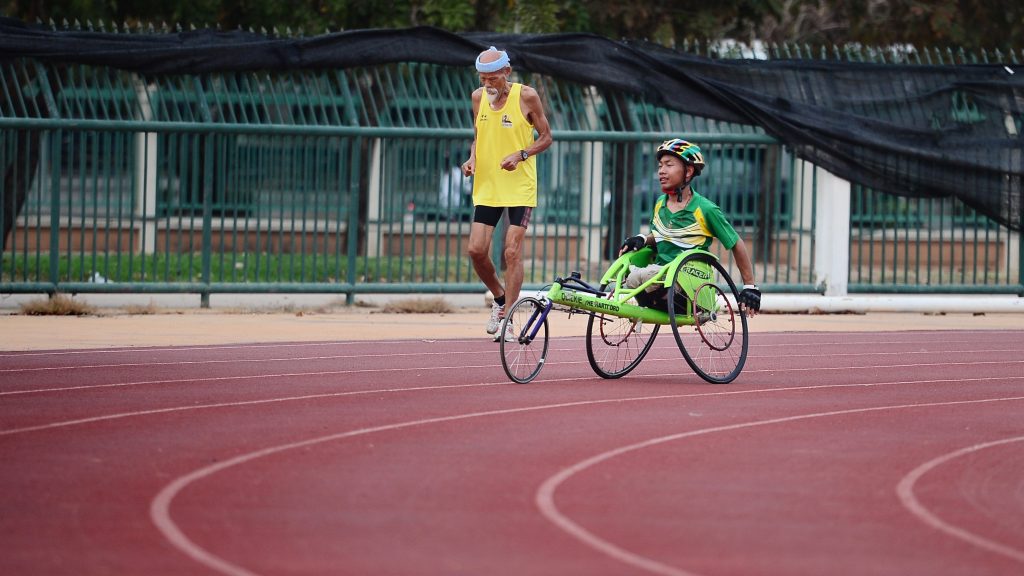Tech and Disability
#Accessibility #Inclusivity
« Tech and disability » is part of the six journeys of the 2018 edition of Futur.e.s: here’s what you’ll be able to discover there. Detailed program and schedule coming soon…
Being « inclusive » has become the new mandate for both private and public actors today. How can we ensure that this word goes beyond talk into action? Inclusivity is about ideas, but above all practices and uses, and Futur.e.s recognises that entrepreneurs are currently creatively tackling this challenge. This theme brings together the latest developments in devices to assist children with motor difficulties; mixed reality solutions to help those with autism as well as a new method of production that could make wheelchairs more affordable. Our aim is to celebrate the actors and tools that are indispensable to achieving real inclusivity.
But it wasn’t enough for us to simply assemble the current solutions on the market. The projects presented here have both specific and more general applications, hence the prototypes are found not only in this specific theme but also in the five others. All the themes are inextricably linked and we know that everyone will be interested in innovations that have the potential to improve everyday life! For example, Ava, a sub-titling tool for the deaf or hard of hearing could also help non-English speakers more easily follow English language presentations.
We are convinced that the metropolis of tomorrow will only be a ‘smart city’ if it is open to people with reduced mobility. The education system of tomorrow will only be strong if it accepts autistic children. The science of tomorrow will only be progressive if it focuses on improving conditions for those who have the most need. And Futur.e.s can only be truly Futur.e.s if it goes beyond a superficial understanding of what inclusivity means.

HANDS ON EXPERIMENTS
- Hol’Autisme by Actimage, an educational and medical solution using mixed reality to help young autistic people develop their social awareness in a secure environment.
- Gaspard, a connected rug created by Captiv placed under an anti-bedsore seat. Thanks to a mobile phone app and bluetooth, it tracks down time spent, positions and the inactivity of the user, in order to prevent skin issues.
- Ordyslexie, an intuitive digital schoolbag intuitif conceived by an engineer team to build confidence for dyslexic children.
- OrCam, a mobile artificial vision tool designed to help the blind or those with poor sight, or anyone who has difficulty reading.
- DysApp by Tralalere, a device to identify and accompany children with motor troubles to improve their written language skills.
- Ava, an application that adds sub-titles to conversations in real time using each participant’s smartphone.
- Artil has imagined Streetco, the first GPS for pedestrians, that adapts to the trips of people with reduced mobility.
discussions
- AI in the service of machine translation and linguistic accessibility: bridges with the world of the Deaf (FR)
- Bigger – and better? Can tech lead to fairer and sustainable metropolises? (FR)
- Hacking territories accessibility (FR)
- Interfaces of tomorrow: no interfaces? (FR)
presenters
- Adrien Meslet, Director of Ava France, which has developed an app for the deaf and hard of hearing, which adds sub-titles to conversations
- Lauren Thévin, postdoctoral researcher, Inria
- Bastien Didier, artist specialised in brain-machine interfaces
- Héloïse Théro, with a background in biology, she is currently completing her PhD at the cognitive neuroscience laboratory at the Ecole Normale Supérieure.
- Audrey Sovignet, former student at École nationale supérieure des Arts Décoratifs and programming school Simplon.co. She founded I Wheel Share in 2015 three years after the accident that made her brother Lucas paraplegic. Read her interview here
- Jérémie Boroy, member of the diversity council of the French authority on audiovisual (CSA)

